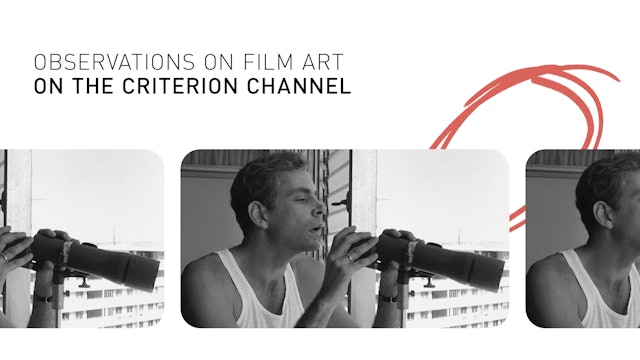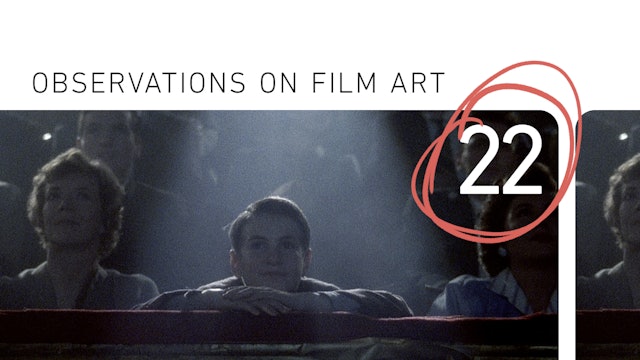Observations on Film Art
-
The Revolutionary Subjectivity of MEMORIES OF UNDERDEVELOPMENT
1 season
Observations on Film Art No. 26
The first Cuban film to garner international attention in the years following the nation’s 1959 revolution, Tomás Gutiérrez Alea’s MEMORIES OF UNDERDEVELOPMENT remains one of the most important works of the influential Third Cinema movement that emerged in the ...
-
Widescreen Composition in SHOOT THE PIANO PLAYER
1 season
Observations on Film Art No. 24
Professor Jeff Smith explores how François Truffaut harnesses the 2.35:1 aspect ratio in his wildly playful gangster-movie pastiche, a giddy high point in the French New Wave’s assault on cinematic convention.
-
Mutations of Memory: Editing in HIROSHIMA MON AMOUR
1 season
Observations on Film Art No. 23
Professor David Bordwell traces the ways in which director Alain Resnais and screenwriter Marguerite Duras retooled cinematic language to evoke the texture of memory in their 1959 masterpiece.
-
Continuity Editing in THE DEVIL AND DANIEL WEBSTER
1 season
Observations on Film Art No. 20
Professor Jeff Smith walks us through the basics of continuity editing and shows how William Dieterle’s faustian fever dream adheres to that code while testing the limits of its expressive potential.
-
Color Motifs in BLACK NARCISSUS
1 season
Observations on Film Art No. 19
Professor Kristin Thompson breaks down the lush palette of Michael Powell and Emeric Pressburger’s sensuous masterpiece, showing how set designer Alfred Junge and cinematographer Jack Cardiff use splashes of color to trace the film’s emotional arc.
-
Staging and Performance in IVAN THE TERRIBLE, PART 2
1 season
Observations on Film Art No. 18
Professor David Bordwell explores the “expressive movement” that animates one of Sergei Eisenstein’s boldest experiments in film form, demonstrating how the director draws on the language of dance and painting.
-
Narrative Symmetry in CHUNGKING EXPRESS
1 season
Observations on Film Art No. 17
David Bordwell unpacks Wong Kar-wai’s intricate approach to double-pronged storytelling in one of the defining works of nineties cinema.
-
The Darkness of War in WOODEN CROSSES
1 season
Observations on Film Art No. 16
Professor Kristin Thompson explores how Raymond Bernard evoked the horror and despair of battle in his shatteringly realistic World War I film.
-
GIRL SHY: Harold Lloyd Meets Classical Hollywood
1 season
Observations on Film Art No. 14
David Bordwell shows how Harold Lloyd helped silent comedy evolve from gag-based skits to increasingly intricate narrative forms.
-
The Stripped-Down Style of ALI: FEAR EATS THE SOUL
1 season
Observations on Film Art No. 10
Professor Jeff Smith illustrates how Rainer Werner Fassbinder’s deliberate blocking and tableau compositions accentuate the social divisions that crisscross his 1974 masterpiece.
-
Staging in THE RULES OF THE GAME
1 season
Observations on Film Art No. 7
Jean Renoir’s THE RULES OF THE GAME is famed for its deep-focus photography and intricate staging. Professor Kristin Thompson analyzes the elaborate construction—and mesmerizing chaos—of Renoir’s symphonic tragicomedy.
-
THE SPIRIT OF THE BEEHIVE: A Child’s Point of View
1 season
Observations on Film Art No. 5
Using the great Spanish film THE SPIRIT OF THE BEEHIVE, by Victor Erice, professor Kristin Thompson shows how restricting us to a child's point of view can make the familiar seem strange and emphasize the horrors of war.
-
The Restraint of L’AVVENTURA
1 season
Observations on Film Art No. 4
Professor David Bordwell applies his analysis of film language to Michelangelo Antonioni’s L’AVVENTURA, illustrating how the director uses careful staging and methodical framing to keep us guessing about his characters’ feelings and motivations.
-
Abbas Kiarostami: The Character of Landscape, the Landscape of Character
1 season
Observations on Film Art No. 3
In the third installment in our ongoing introduction to film language, Professor Kristin Thompson offers an analysis of the legendary Iranian filmmaker Abbas Kiarostami's quiet genius.
-
Quicker Than the Eye: Editing in SANSHIRO SUGATA
1 season
Observations on Film Art No. 2
Our home film school continues with David Bordwell’s analysis of Akira Kurosawa’s first film, a showcase for the powerhouse director’s range of talents.


























